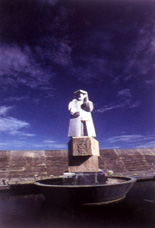
The Portuguese arrived in Japan in 1543, but the memory of this event is still very much alive in the Land of the Rising Sun as symbol of a page turning from the Middle Ages into modern times. That year would forever mark Japan's opening up to the West, the first step towards the "Japanese miracle". As important as the research work of Japanese scholars (so much so that it is present in history books and museum halls) Tanegashima's tradition and legend revives year after year the memory of the first nambans who arrived on their shores, with two muskets on their shoulders.
Everything in Tanegashima bears a reference to Portugal. Upon entering the harbour, the hero depicted in the island's largest statue, on the dock, is Prince Henry The Navigator. Here, he is simply known as "The Man from the Sea".
Small Tanegashima would still be today one of the hundreds of forgotten islands lying in the South of Japan, were it not for its connection with the introduction of fire arms into Japan. It was from the island's smithies that the mass-copied Portuguese guns got into the hands of those 16th century generals. One of them would eventually come out the victor of a civil war (ongoing for over one hundred years) and undertake Japan's reunification.
In the very beginning, the Japanese did not know what to call this new gadget. So, they referred to it merely as the tanegashima. Later on, muskets or hackbuts were called teppo and this remained their name.
400 YEARS LATER
Tanegashima residents are well aware that their island owes its fame to the fact that the Portuguese musketeers first landed there.
In July every year, the Teppo Matsuri (the Gun Festival) brings everyone together in the most moving celebration of Portuguese seamanship in the Orient. It is the island's most important festivity, a public holiday, a time when people from neighbouring islands and, most important of all, Tanegashimaborn homeseekers, flock to town.
The excitement begins in the week before, because several tasks have to be completed: the decoration of streets, the painting of banners, the cleaning of old muskets and the construction of the huge "nau" from Portugal which is to take Mendes Pinto and his legendary Japanese lover parading through the streets of the island.
Nishinoomote is no longer a dull small fishing town. It becomes the stage of the Teppo Matsuri.
The festivities continue for two days, sometimes three. Early in the morning, local dignitaries gather at the mausoleum of the Tanegashimas (the island's lords when the Portuguese first landed there) to pay tribute to Lord Tokitaka, the young daimyo who succeeded in obtaining the secret of the trigger from the Portuguese.
The island's chief monk presides over the ceremonies which are also attended by Tokikuni Tanegashima, 29th clan leader who, every year, comes down from Kagoshima where he works as an engineer.
It is in this more recent mausoleum that the ashes of Tanega's daimyos have been kept for the past six hundred years, in small burial monuments arranged in chronological order.
Tokitaka is the only ancestor summoned to take part in the festivities. His tomb is covered with wild flowers and, on a makeshift table in front, a ritual meal awaits the awakening of his spirit.
There is fish fresh from the net, a small bottle of locally-made sake and a silver tray bearing the first fruits of summer.
A fresh sea breeze gently flutters the surrounding beech trees. No one can tell whether it is the voice of the waves so close by or the whisper of the old Tanega souls, waking up to the monk's timeless litany.
This ceremony is followed by the official payment of respects to Tokitaka, which takes place in front of the statue erected in his honour on the spot where the daimyo saw, for the first time, the Portuguese muskets at work. Forever captured in bronze, it reflects the feudal lord's amazed stare at the sound of the first shot he heard. A Buddhist monasterial chronicle claims that he immediately realized that "that gadget was the world's most extraordinary thing".
On the hillside where the palace once stood, Tokitaka, still wearing the two Samurai swords and holding the historic musket, stands facing the "Museum of the Gun".
This museum in the form of a Portuguese caravel is another of Tanegashima's prides, where the first gun specimens made in accordance with the Portuguese model are kept and are on show.
THE FESTIVAL OF THE GUN
Tanegashima retains the traditional school of shooting with old fire arms. In Wakasa Park, the parade's thousands of extras in their colourful costumes gather in front of the Bullet Monument. It is an unique sight.
Summer smells are enhanced by a chorus of a million locusts blended with John Philip de Sousa's tunes (but, alas, no one knows that this great American composer who is the soul of military bands all over the world, was a descendant of a Portuguese family from the Azores).
Around the park's clearing, looking out for a comfortable shade under which witty remarks are exchanged, a happy crowd gets together: Fernão Mendes Pinto, wearing a "Sagres" marine officer's uniform, an uneasy looking Wakasa, the eternal bride, Chinese pirates wearing queues and fully-clad Korean archers, a proud Tokitaka, old time musketeers wearing combat dress, Tanega's old blacksmiths, feudal ladies-in-waiting and, everywhere, Portuguese adventurers with their colonial breeches and big twisted moustaches.
Shooting school delegations arrive from Kunitomo and Sakai (the heroic trading city which saw the rise of Osaka). Together with Tanegashima's own musketeers, they are going to participate in an aiming competition with flint hackbuts. Kunitomo and Sakai (only second to Tanegashima) are Japan's oldest shooting schools.
The firing command is given by a samurai commander, who has been referred to as Kapitan since the 16th century when this Portuguese word was introduced and spread throughout the country.
The Mayor's address follows next. Before numerous guests (delegations from Sakai, Kunitomo, Okinawa and Tokushima are easy to spot) he recalls the history of the island, the arrival of the Portuguese and the friendly manner in which they were received by the islanders, the first Portuguese-Japanese love story which would further contribute to the unification of the country, by means of the gun which wiped out armies and hastened the end of wars.
Tanegashima proudly assumes itself as the outset of modern Japan. Her heroes are a blacksmith who used to manufacture scissors, his daughter Wakasa, her lover Pinto and a young, shrewd and liberal daimyo.
The naїve scenes of the parade, where history is blended with legend, bring the Portuguese great "nau" with its huge red Cross of Christ back from the dust of the centuries. On board, are Wakasa sitting on a banko ('banco' - bench) and wearing her red birudo ('veludo' - velvet) kappa ('capa'- cape) next to the piroto ('piloto' - pilot) Pinto San, accompanied by the first Portuguese-Japanese mixed blood child and the Portuguese captain's Chinese mates.
On foot, escorting the "nau", follow the other friends of the captain: 15th century Portuguese men in their ancient robes (who may as well, have just popped out of some Japanese screen) marching uneasily carrying muskets on their shoulders and tall hats on their heads, golden-buttoned giban ('gibгo' - jerkin) and wide breeches that are still called karusans ('calзхes'). These are the nambans from Porutogaro.
The group of Chinese who, once upon a time, brought the kapitan in their ship follows next, escorted by the court of Tokitaka who, riding his black sorrel, is the last of the procession.
Up in front, the parade started off with the float of the the island's beauty queen, followed by schoolchildren marching to the tune of traditional charumeras (whilst, at the same time, a band of musicians playing plastic fifes whistles the "Bridge over River Kwai" unaware-or perhaps not-of the significance conferred by the movie to this march during the American-Japanese war).
The spectators crowding the streets vibrate at the passage of each participant trying to match the faces behind the disguises with their real-life names.
Every now and then, the parade stops at the more crowded vantage points, to enable musketeers to show their skill at shooting the old hackbuts.
But the liveliest moment comes with the Teppo Odori (the Dance of the Gun). Thousands of peasant women from all parts of the island bring up the rear, dancing to the sound of that traditional melody for hours on end.
It is a sort of medieval minstrel song, filled with the longing for the lovers who are holding their muskets, preparing themselves for combat:
"Be courageous, my love. Remember the rhythm of this song. And let not your arm shake. When it is time to aim."
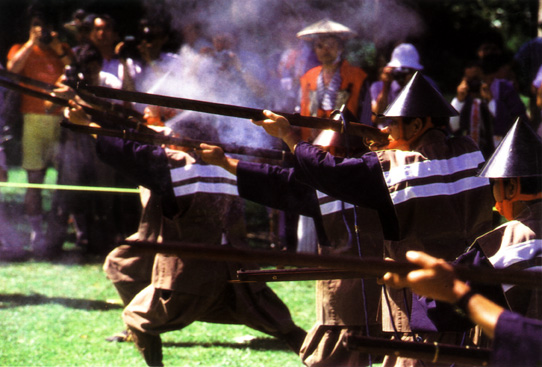 Demonstration of Guns from the 16th C., in the Gun Festival.
Demonstration of Guns from the 16th C., in the Gun Festival.
The undulating motion of the dancers, extended by the waves of the kimonos, adds an erotic, subtle touch to the aiming gesture.
It is almost mid-afternoon. the parade takes two hours or more to go through the beautifully decorated streets of Nishinoomote, in which the Christian "nau" is depicted again and again in posters, banners, shop-windows, sometimes a tall-hatted namban lying among bric-a-brac and Toyota advertisements, or hanging from coloured paper garlands.
Late in the afternoon, when the parade is drawing to a close, it is time for the traditional supper, shared in the company of family and friends. The menu consists of sakana (which must have turned the stomachs of the first Portuguese seamen in Japan, who could not forget the unpleasant experience and who on their return to Portugal, started to name people whom they disliked after that particular dish).
This raw fish delicacy is accompanied by a tchavan ('chбvena' - cup) of cha ('chб' - tea), because red chinta ('tinto') wine had not been available since the Black Ship stopped bringing it from the Portuguese Province of Ribatejo.
But there is plenty of tempora, which are deep-fried prawns and vegetables coated in batter. This was the missionaries' diet during the "tкmporas" (liturgical abstinence periods) when they were forbidden to eat waka ('vaca' - beef) meat.
Here comes the desert: today, there is boro de bobura ('bolo de abуbora' - pumpkin cake), biskoitos de amendo ('biscoitos de amкndoa' - almond biscuits), karumera ('caramelos' - caramel candies) and, most important of all, castera ('castela', a typical Portuguese cake made with whipped egg whites).
To wash everything down, there is nothing better than some satsuma sake, an alcoholic beverage made of sweet potato juice and named after the port town of Satsuma, where sweet potatoes are said to have been introduced by Portuguese merchants.
Night falls. In the yard of the shintoist temple - which according to the island's tradition is said to have sheltered the first Portuguese in 1543 - the popular festivities are still on. Food and drink stalls offer simple and light food, which is eaten on the floor: a handful of kashuu ('cajъ' - cashew kernels), pan with manteika ('pгo com manteiga' - bread with butter) or some masan ('maзг' - apple) or marmeru ('marmelo' - quince), cut with a haca ('faca' - knife) or a isupada ('espada' - sword) or a katana ('catana' - dagger), that will be used later, on the stage.
Dances and theatre games fill the summer night. Visitors let themselves be overcome by the spell of graceful peasants on stage, the splendour of their costumes, the different shades of light cast by the paper balloons.
Portugal and Europe are, by now, only a faint recollection somewhere between dream and reality.
THE GIRON PARADE
The second part of the Tanegashima festival is the Giron Parade. It is a popular Shintoist event held on the second day of the festivities, which is also characterised by not having any of the formalities of the previous evening.
Participants get together in front of the temple which sheltered the first Portuguese who came to the island as well as Francis Xavier himself, so we are told (a very plausible theory because Tanega was a feudal estate of the Shimazu clan in Kagoshima who sheltered Xavier for a long time).
Once again, the Portuguese flag flutters beside the Japanese pavillion, on top of a small monument erected in honour of Portugal.
After the monks' short prayers, the parade begins with religious pomp. The melody of a flute fills the air as softly as the voices of small children dressed in the most beautiful pastel colours imaginable.
The Shintoist float has already passed by, a link between nature and the immortal gods, carried on the shoulders of strong young men, in the undulating motion of a boat on the waves. Oisho! Oisho!
When they reach the beach, the young men enter the water still carrying the float over the waves. Flowers are set free in the foam, as offerings to the spirit of the waves. It is the consecration of the sea, the pagan rite of cosmic communion with the forces of nature.
Little by little, the long parade turns into some sort of carnival, where each of the island's schools depicts a popular theme. A feast of rhythm and fantasy, made even livelier by the children's shouts.
But most importantly the allegorical constructions remind us of caravels, decorated with the Portuguese cross, and images of Wakasa and Mendes Pinto. It is the history of the island, its legends and small time heroes, not to mention the musket and the scissors joined together in the honour of the industrial transformation which the island has undergone since the arrival of the nambans.
And to make it more real, the Shintoist parade ends with another one, led by a medieval warrior. Only this time, it is a parade of a purely commercial nature...
It is the whole island of Tanegashima, Japan's Buddhist soul, shaping life and carnival.
Life in Tanegashima revolves around the gun and Mendes Pinto's romance. Local artefacts for tourist consumption sometimes carry the image of a gun, associated with spaceships that are launched from the modern nearby space facilities of Nishimura.
The nambans' gun is present everywhere: tie-pins, window-valances, labels on sake bottles or even boxes of locally made biscuits.
Traditional dolls, on the other hand, invariably represent "Princess Wakasa", holding a gun in her arms.
Even the island's shoemaker turned sculptor but he only knows how to make musketeers.
THE PORTUGUESE ARRIVED IN JAPAN
The Portuguese arrived in Tanegashima by chance. But they would have got there sooner or later anyway, just as they went everywhere This remark by historian Charles Boxer is based on the fact that the Portuguese were present in all Eastern routes in the 16th century.
After the conquest of Malacca in 1511, Portuguese merchants rapidly absorbed the expertise of their Indian, Philippine and Indonesian fellow traders, and travelled to all trading harbours in the Indian Ocean, China and the East.
Afonso de Albuquerque, himself, and the official historians of his time (such as Tomй Pires, Castanheda and Joгo de Barros) mention the inhabitants of the Kingdom of Ryukyu in Southern Japan.
Since 1518, King Dom Manuel had been advised to send a fleet to discover the islands of Ryukyu. It is likely that some Japanese boats had anchored at Malacca's harbour and, on the other hand, it is known that trade between China and Japan was never discontinued, although an imperial Chinese decree of the end of the 15th century had officially forbidden trade. Mendes Pinto, in his "Peregrinaзгo", describes in detail the trading post of Liampou, in the Chinese coast facing Japan. Portuguese, Chinese and Japanese would set anchor there and carry on their trade.
Nevertheless, Japan would continue unexplored. Before 1543, it seems that the Portuguese only knew (and even so, secretly) some of the Ryukyu islands, located in Southern Japan where modern Okinawa lies today.
Strategic Malacca was the "head and the key to the Southern seas", as Afonso de Albuquerque used to say. It was the Portuguese outpost in the East.
From Malacca on, the Portuguese were the masters of the sea, from Coromandel on the Indian East coast, to as far as China and the great Indonesian Archipelago.
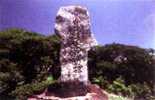
1 Monument to the meeting between East and West at Cape Kadokura on the beach where the Portuguese arrived in 1543.
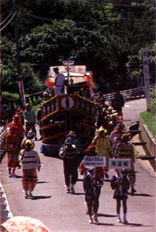
2 Boat and people dressed as 16th C. Portuguese in Japan in the "Gun" parade
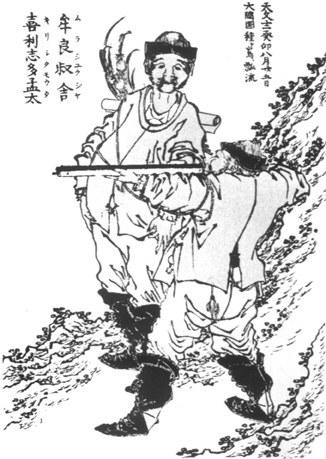
3 The first shot fired by the Portuguese in Japan - drawn by Hokusai, one of the greatest Japanese artists (1817)
Everything aided the Portuguese in discovering the great trade centres: the prestige of the "naus", the might of their weapons, a partnership with local traders and even with China Sea's pirates. So, in all sea routes, there were noblemen and adventurers, soldiers and hooligans, rich merchants and fiery missionaries. It was not a 'cross and sword' epic (only a few would actually see it that way) but rather a huge individualistic effort by the new Portuguese bourgeoisie, supported in a way by the Crown, looking for riches and eager to expand the Christian faith.
There were also the Empire's marginals, who were trying to evade the royal authority, Goa's control and the Malacca captains. Shortly after Albuquerque's death in 1515, there were already many Portuguese who, because of their lack of resources or faith, did not mind risking it all in suicidal trips, trying their luck on Eastern seas, sometimes paid by the enemy.
Mendes Pinto is one of these adventurers. His "Peregrinaзгo" describes exactly his first trip to Japan, aboard a Chinese pirate junk tossed in a storm to Tanegashima's shore. It would have been on that occasion that a travelling mate, Diogo Zeimoto, dazzled the daimyo with the Portuguese gun.
Mendes Pinto's description coincides in all major points with the famous Teppo-Ki (Chronicle of the Gun), written by a Zen monk in 1607, that is, sixty years after the facts that are told had taken place, and some time after Mendes Pinto's version (1578).
The Japanese chronical was written in classical Chinese at the request of one of Tokitaka's grand-children who thus chose to glorify his grand-father's memory. The writer was an historian monk of the powerful Shimazus of Satsuma, in Kagoshima Province, Tokitaka's suzerains.
THE GUN WHICH UNIFIED JAPAN
In Japan's military history, the introduction of the gun was a decisive factor. One of the first enthusiasts of this new arm was the great general Takeda (the War Lord in Kurosawa's film). But he was already old and could not adapt to the new technology. Once, and having set his tactics of the battle on the gun shooters regiment, he lost it to a minor military chief because of his attachment to the old medieval war rituals.
Japanese medieval military tactics encompassed a series of war games and demonstrations of expertise which were performed in the neutral zone between the two warring armies before troops would engage in battle. Only after the rituals was the carnage allowed to start.
It happens, however, that spears and arrows are swifter than the lint gun: loading, lighting the flint, emptying the powder-horn and aiming would take about two to three minutes. Thus, before being even ready to fire, a musketeer would be pierced by countless enemy arrows.
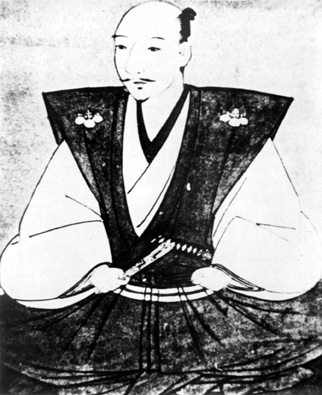
Oda Nobunaga-one of the greatest military geniuses of the 16th C., he was the first to understand the new weaponry and to translate his knowledge into military tactics. He was victorious in the Japanese feudal wars and reunited the Land of the Rising Sun.
But the new technology was immediately understood by a young chief, Oda Nobunaga, a true military genius, who was just coming into his own. He saw that a slow gun should be used as a defensive weapon and that to produce a constant barrage of fire musketeers had to be positioned in three rows, corresponding to the three steps of the musket (charge, light the lint and aim). And these were the tactics he used in the battle of Nagashino, where three thousand muskets in three rows were ordered to the battle front, ready for Takeda's cavalry and samurais.
The 1575 Battle of Nagashino marks the final victory of the gun over the old medieval chivalry (one should remember the dramatic scenes of Akira Kurosawa's "Kagemusha"). The tactics of modern infantry had thus been discovered, and very few changes would be made until the 1914-18 World War.
From then on (and only 32 years had ellapsed since the arrival of the Portuguese gun) Nobunaga made his way to Kyoto, towards the unification of Japan, which would be accomplished by his deputy, Toyotomi Hideyoshi, whilst the political organization of the new country was carried out by shogun Tokugawa leyasu, once another young commander under Oda.
Three architects of modern Japan, three generals who knew how to take advantage of new technology, at a time when a rising mercantile class and the opening to Western rationalism (introduced by the Portuguese Mission Jesuits) made possible the first historic step which would put Japan in the forefront of all Asian countries.
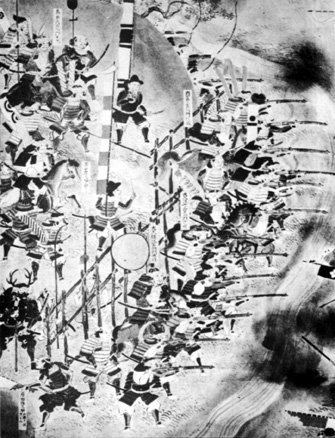
1 The Battle of Nagashino (1575) - marked the historic triumph of the firearm over medieval cavalry.
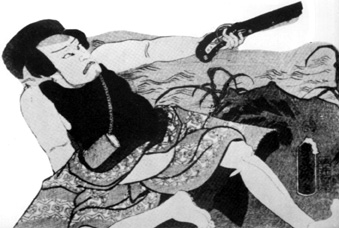
2 "Kabuki" scene (18th C.). Engraving by Toyokuni showing a warrior with a pistol. The fascination with the firearm was reflected in the arts. Almost seventy years beforehand, the Portuguese had been the first to use pistols which were later developed by the Japanese.
IT SEEMS THEY WANT TO KEEP YOU INSIDE THEIR SOUL
The Portuguese have always admired the Japanese people. It is not by chance that the name of Jampom itself was introduced in Europe around 1515, by a Malacca historian, the renowned Tomé Pires.
The first sociological portrait of the Japanese mentality was given by sea-captain Jorge Бlvares at the request of Francisco Xavier who, in turn, sent it to Rome to justify, before Inбcio de Loyola, his decision to leave India for Japan.
It was the description of this man from the Portuguese village of Freixo de Espada а Cinta, which encouraged Xavier to take to his Japanese adventure.
"I travelled three leagues inland (so tells the sea-captain Jorge Бlvares), saw well groomed and fertile mountains. It is a beautiful, shady land. The people are generous and gentle and very devoted to their idols. They are proud and given to military arts and very skillful with their big bows. They are liberal people. If you are travelling to their land, it seems that they want to keep you inside their soul".
After arriving in Kagoshima, a few leagues away from Tanega, Xavier wrote: "Those with whom we spoke so far, are the best of all the people we have encountered, and among the infidel it seems that no others will exceed the Japanese".
"If we were to write down all the good things about them", writes one of Xavier's companions, "we would rather lack paper and ink than subject matter".
A visit to Nishimura is a must, if you go to Tanegashima. Cape Kadokura, overlooking the beach where the Portuguese landed for the first time, is filled with many memorial monuments. One of them, without referring to Portugal, celebrates the first Japanese contact with the West.
More modern is the stone block in memory of the Portuguese pioneers, beside the memorial of the "Sagres" sailors, whose visit to Tanegashima was never forgotten.
Among these memorabilia, a Shintoist stone is a moving monument in honour of Japanese soldiers and their Western enemies who died in the last World War.
Guarding these relics, is a reinforced concrete caravel, which is the cliff's highest lookout. None of these stones has special artistic value, but they are filled with history.
This is almost a sacred place to modern Tanegas. For them, it is not by chance that the spaceship launching platform lies in the vicinity, so close to the Nishimura beach. They say that the Japanese world renowned for technical mastery began with the namban's gun and became a spaceship.
The past has become the present. A symbol only - or mere coincidence. But in Tanegashima, the Island of the Gun, everyone believes that modern Japan was born out of a love story, aboard a Portuguese "nau".
"As far as I know", says Tanega's Mayor, "that was the first marriage ever, between westerners and Japanese. And I wish from the bottom of my heart that the friendship between Japan and Portugal may live forever.
Arigato! 'Obrigado' (Thank you)".
(Extract from the book Tanegashima, the Island of the Portuguese Gun, written by Avelino Rodrigues and published by ICM with photographs by Leong Ka Tai and edited by Gonзalo Cйsar de Sб).
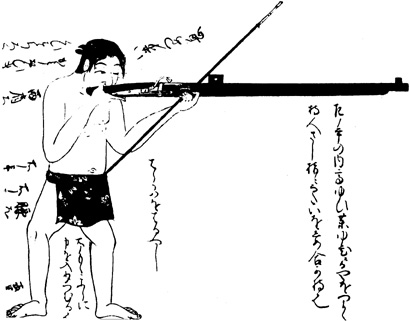
Page from the shooting instruction manual "Thirty Two Firing Positions" from the Inatomi Shooting School (1595).
Each engraving has captions with technical instructions and lines indicating the angle of vision.
The man is unclothed, not because the Japanese fought like that but to show more effectively the correct position of the limbs and the muscles.
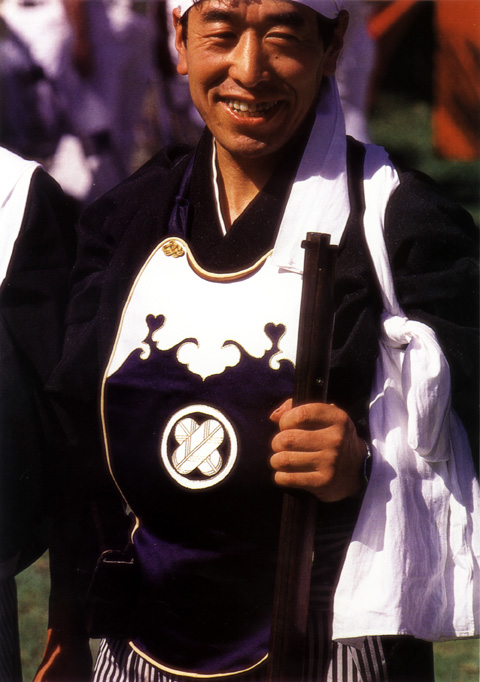
start p. 75
end p.